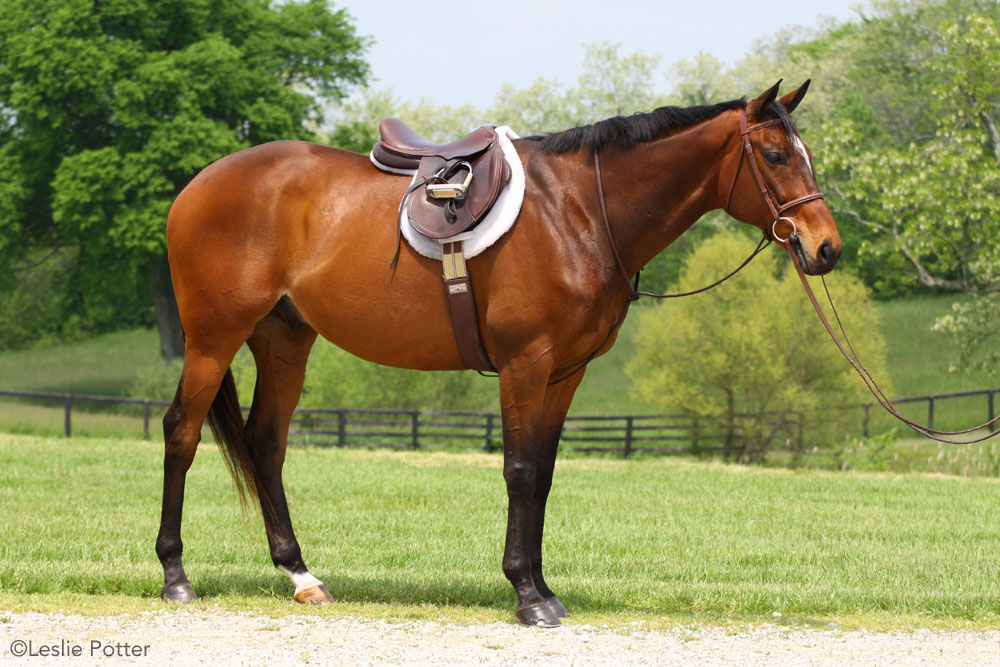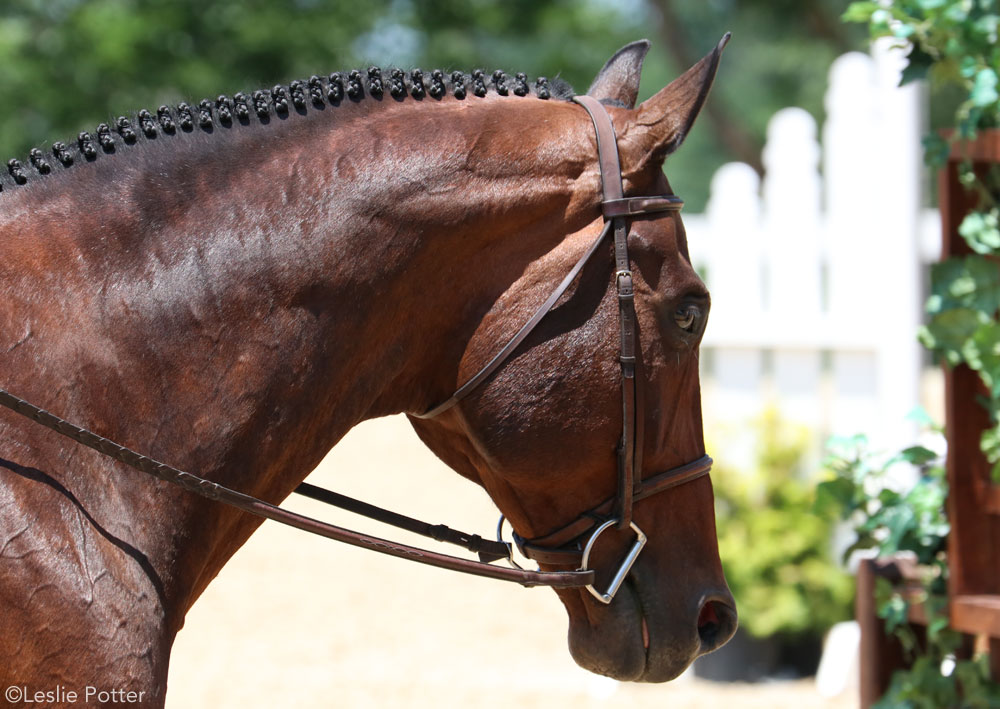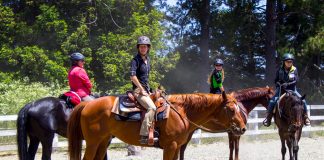A Shine and a Shave
A hunter should step into the show ring looking well-fed and healthy, not like it was pulled out of the pasture the day before and furiously scrubbed at the last minute. Getting a glow on your hunter begins with providing a nutritional diet all year long. To help his coat shine from the inside out, consider adding a commercial coat enhancement product or simply adding a cup of vegetable or corn oil drizzled over a small ration of pelleted feed each day. Regular grooming, and blanketing when appropriate, will also help him look like a winner.
Once you’re set on a certain show, it’s time to tidy up your hunter’s turnout. Begin with the clippers. If it’s late autumn or early winter and you’re dealing with a furry hunter, then you’ll need to do a thorough body shave, especially if you’re competing at a regionally-rated (or higher) show for medals and year-end awards. Yet there are also year-round clipping chores.
Whiskers on your horse’s chin and under his jaw should be shaved off cleanly. Clipping the inside folds of the ears isn’t necessary except for the larger rated shows. But your hunter’s ears can’t look scruffy, either. As a compromise, hold his ear closed with one hand (press lightly so he doesn’t rebel) and follow the outer contours, removing any fluffy tufts. Go slowly so the ears don’t end up with ruffled or jagged edges.
Next clip the fetlocks and any long hairs that coarsen the lines of the lower leg. Be sure to clip with the growth of these long hairs, however, or you could end up giving a two-toned look to your horse’s legs. If your horse has ringlets of hair cascading over his coronet bands, carefully trim them back to make a nice, neat edge at the rim of each hoof. When it’s time for the bridle path, use your clippers with discretion. Though some breed show circuits prefer elongated bridle paths, hunters on the open circuit are much more conservative. The bridle path should be just long enough to accommodate the crownpiece of your bridle, about 2 inches.

Mane and Tail Management
Braiding a show hunter’s mane used to be part of the standard turnout, but that tradition has all but disappeared from the local show circuits. In fact, most hunter shows that aren’t A- or AA-rated by the United States Equestrian Federation (USEF) request that the horses are left unbraided, so that every horse has a uniform presentation. Yet if you’re competing at a rated USEF show, a special local event (like a highly promoted charity show) or the year-end finals of your regional association, then you’ll want to braid your hunter’s mane.
Keep in mind that not everyone has the manual dexterity required to expertly braid a mane. If you don’t have time to perfect your skills at home before the show then hire a professional braider. Few things look more disheveled in the show ring than a bad braid job. Since the services of a professional braider aren’t cheap (expect to pay around $40-$50), consider zipping a stretchy lycra hood over your horse’s head and neck to preserve his braids overnight and during long stretches between classes.

Regardless whether or not braiding is in your hunter’s future, keep his mane thinned and pulled. It should be about 4 inches long and lie flat. Hunters traditionally have their manes on the right side of the neck. If your horse has an untamed mane use little elastic bands to temporarily work his mane into a row of short “pigtails.” Repeat the job every few days, being sure to smooth out the kinks with a damp brush before braiding again. Soon your horse’s mane will cooperate.
How to braid your horse’s mane for hunters >>
Though the mane needs frequent attention, a hunter’s tail is mostly allowed to go au naturel. The tail is braided just for major shows and high-profile events, and only when the mane is also braided. Otherwise it’s simply left long and full, and generally the less you do with a hunter’s tail, the better. The exception is a tail that’s extremely wispy due to genetics or ragged and stubby because of a mouthy stable mate. In those instances, you might consider tying in a modest fake tail.
How to braid your horse’s tail for hunters >>
Show Day Sparkle
Though every hunter needs a sudsy shampoo before a show, gray coats and white stockings present a challenge. Luckily there are plenty of shampoos designed to remove yellowing build-up and green manure stains. For deep dirt on white stockings, apply the shampoo full strength and scrub it in with the help of a long-handled kitchen sponge or soft brush. Let it sit for a few minutes then rinse thoroughly. In fact, always make sure you rinse these shampoos extra carefully, or your horse could end up with a bluish tinge. Once your horse is dry you can preserve the white areas two ways. One is by spraying the hair with a coat polish, which helps repel dirt and dust. Just be sure not to use a slick, silicone-based product in the saddle area. The other is by using a barrier, like a blanket or daysheet. To cloak white stockings, wrap them.
Hunters of all coat colors need to look relaxed and expertly groomed before they go before the judge. So when you’re at the show, give yourself plenty of time to warm-up so your horse can get some last-minute attention before he heads through the in-gate. Try not to enter the ring with a sweaty horse. If you have time, use a damp sponge sparingly to wipe down areas wet with sweat, like the outline of your saddle pad or your horse’s flanks. Allow several minutes to dry then brush the coat smooth again. If your horse is dusty, a terry cloth towel works great as a rub rag to add some last minute polish.
The two final parts of your hunter’s presentation include his hoofs and his mouth. While black hoof paint and lacquer-like polish are frequently found at some breed shows, simple hoof oil is all that’s required in the hunter division. If your horse has white stockings, stick to a clear hoof conditioner or he’ll end up smudging his legs with dark spots. Then turn your attention to your horse’s mouth. A little drool of saliva is fine, but if your horse’s lips are foamy white or sporting orange chunks from that carrot you slipped him, then use a separate rub rag to wipe it off. The bit should be shiny and free of gunk and goo. You don’t want anything to detract the judge’s eye from your horse’s performance, especially not a slimy, dirty mouth.
Though presenting a hunter takes some practice, it can be done for any level of showing. Spend some time before the show working your grooming magic, and then pay close attention to the last minute details before you enter the ring. Then your hunter will look the part and be worthy of a blue ribbon.






Great tips for beginner horse show-ers! Thanks!
good info. this is fun
Good jo HC! I love this.
Good information, well said.
So cool!
interesting to see the contrast between this and western show grooming